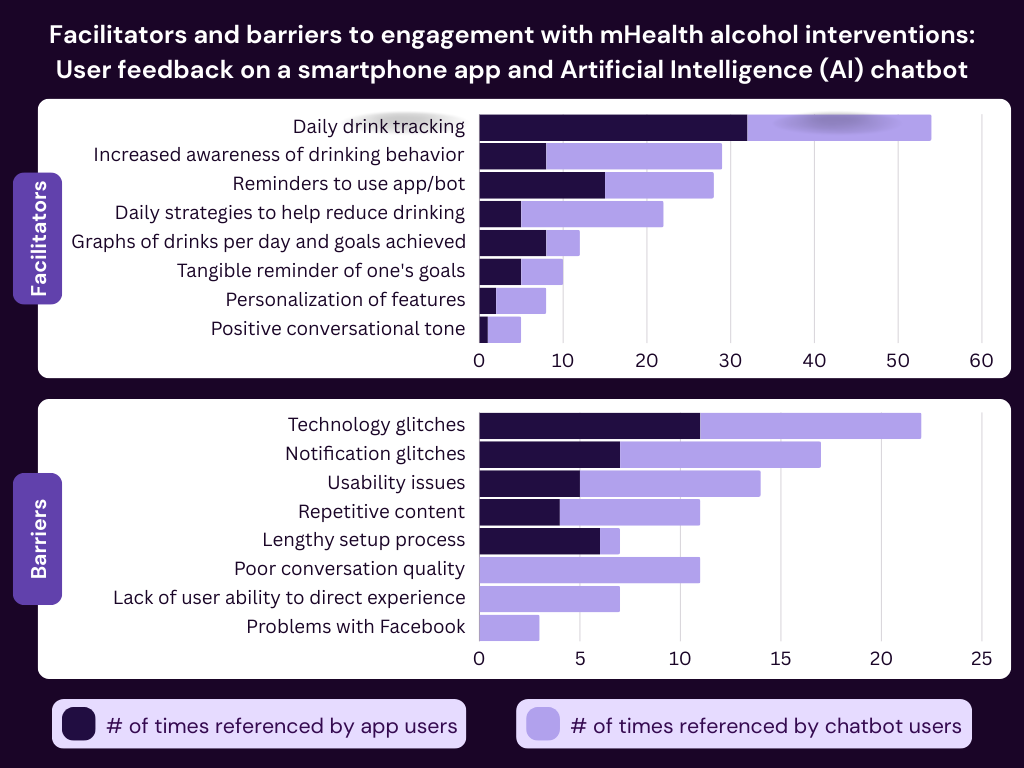The World Health Organization defines mobile health (mHealth) as “medical and public health practice supported by mobile devices, such as mobile phones, patient monitoring devices, personal digital assistants (PDAs), and other wireless devices”. mHealth interventions have shown promise for addressing various health behaviors, including alcohol use. This week, The DRAM reviews a study by Robyn N.M. Sedotto and colleagues that identified facilitators and barriers to engagement with mHealth alcohol interventions among adults at-risk or high-risk for hazardous drinking.
What are the research questions?
(1) What are facilitators and barriers to engagement with mHealth alcohol interventions? (2) Do these facilitators and barriers change with different intervention delivery methods (i.e., smartphone app versus Artificial Intelligence (AI) chatbot)?
What did the researchers do?
The researchers used Facebook advertisements to recruit adults in the U.S. at-risk or high-risk for hazardous drinking according to the Alcohol Use Disorders Identification Test (AUDIT). Participants received the Step Away alcohol intervention, either via smartphone app or Facebook Messenger chatbot. Step Away aims to help users manage their drinking through the principles of motivational enhancement therapy, relapse prevention, and community reinforcement; it was originally developed for use among veterans in primary care. After twelve weeks, 20 participants provided feedback on features of the app or chatbot that promoted engagement (facilitators) and features that diminished engagement (barriers).
What did they find?
Among both groups, the most common facilitator to engagement was the ability to track daily drinks, though app users mentioned this feature more than chatbot users (see Figure). Experiencing technology glitches was the most common barrier to engagement for both delivery methods. Poor conversation quality, lack of ability to direct their experience, and problems with Facebook were barriers unique to chatbot users.

Figure. Facilitators and barriers to engagement with mHealth alcohol interventions. Participants received the intervention via smartphone app or AI chatbot and then provided feedback after 12 weeks. Graphs display the number of times each facilitator or barrier was referenced by app users and chatbot users. Click image to enlarge.
Why do these findings matter?
Tracking drinks, increasing awareness of drinking behavior, and receiving reminders helped participants engage with the intervention. On the other hand, technical difficulties discouraged continued engagement. With new products and features and lower price points, mHealth tools and interventions are becoming more widely used. Unfortunately, most people tend to stop using mHealth interventions, sometimes prematurely. Researchers and companies should include features that the target audience finds appealing and make these features easily accessible on the platform, while also innovating their way out of some of the aforementioned barriers (e.g., technology issues) that deter use.
Every study has limitations. What are the limitations in this study?
The researchers recruited participants via Facebook advertisements, so the sample may be more comfortable with technology than the general population of at-risk drinkers. Also, although over 100 participants received the intervention, only 20 provided feedback due to limited time and resources. The researchers recruited both high and low engagement users for these feedback interviews, but the 20 interviewees may have had different experiences than those who did not respond to the interview recruitment attempts.
For more information:
The National Institute on Alcohol Abuse and Alcoholism has tips and resources for people struggling with problem drinking. For additional drinking self-help tools, please visit our Addiction Resources page.
— Caitlyn Matykiewicz, MPH
What do you think? Please use the comment link below to provide feedback on this article.




